Following a little the case of a linear function I think it might be done similar. Solving for the Lagrangian, though, seems to be very tedious, while possible of course. A made up a different measure that seems plausible and should give very similar result. Taking the error ellipse I rescale it such that the graph becomes a tangent. I take the distance to that touching point (X_k,Y_k) as measure for chi-square, which is calculated from (x_k-X_k/sx_k)**2+(y_k-Y_k/sy_k)**2. It is plausible as in case of pure y-errors this is the standard least square fit. For pure x-errors it just switches. For equal x,y-errors it would give the perpendicular rule, i.e. shortest distance.
With the according chi-square function scipy.optimize.leastsq already provides the covariance matrix approximated from the Hesse. In detail one has to scale it, though.
Also note that the parameters are strongly correlated.
My procedure looks as follows:
import matplotlib
matplotlib.use('Qt5Agg')
import matplotlib.pyplot as plt
import numpy as np
import myModules.multipoleMoments as mm
from random import random
from scipy.optimize import minimize,leastsq
###for gaussion distributed errors
def boxmuller(x0,sigma):
u1=random()
u2=random()
ll=np.sqrt(-2*np.log(u1))
z0=ll*np.cos(2*np.pi*u2)
z1=ll*np.cos(2*np.pi*u2)
return sigma*z0+x0, sigma*z1+x0
###function to fit
def f(t,c,d,n):
return c+d*np.abs(t)**n
###to create some test data
def test_data(c,d,n, xList,const_sx,rel_sx,const_sy,rel_sy):
yList=[f(t,c,d,n) for t in xList]
xErrList=[ boxmuller(x,const_sx+x*rel_sx)[0] for x in xList]
yErrList=[ boxmuller(y,const_sy+y*rel_sy)[0] for y in yList]
return xErrList,yErrList
###how to rescale the ellipse to make fitfunction a tangent
def elliptic_rescale(x,c,d,n,x0,y0,sa,sb):
y=f(x,c,d,n)
r=np.sqrt((x-x0)**2+(y-y0)**2)
kappa=float(sa)/float(sb)
tau=np.arctan2(y-y0,x-x0)
new_a=r*np.sqrt(np.cos(tau)**2+(kappa*np.sin(tau))**2)
return new_a
###for plotting ellipses
def ell_data(a,b,x0=0,y0=0):
tList=np.linspace(0,2*np.pi,150)
k=float(a)/float(b)
rList=[a/np.sqrt((np.cos(t))**2+(k*np.sin(t))**2) for t in tList]
xyList=np.array([[x0+r*np.cos(t),y0+r*np.sin(t)] for t,r in zip(tList,rList)])
return xyList
###residual function to calculate chi-square
def residuals(parameters,dataPoint):#data point is (x,y,sx,sy)
c,d,n= parameters
theData=np.array(dataPoint)
best_t_List=[]
for i in range(len(dataPoint)):
x,y,sx,sy=dataPoint[i][0],dataPoint[i][1],dataPoint[i][2],dataPoint[i][3]
###getthe point on the graph where it is tangent to an error-ellipse
ed_fit=minimize(elliptic_rescale,0,args=(c,d,n,x,y,sx,sy) )
best_t=ed_fit['x'][0]
best_t_List+=[best_t]
best_y_List=[f(t,c,d,n) for t in best_t_List]
##weighted distance not squared yet, as this is done by scipy.optimize.leastsq
wighted_dx_List=[(x_b-x_f)/sx for x_b,x_f,sx in zip( best_t_List,theData[:,0], theData[:,2] ) ]
wighted_dy_List=[(x_b-x_f)/sx for x_b,x_f,sx in zip( best_y_List,theData[:,1], theData[:,3] ) ]
return wighted_dx_List+wighted_dy_List
###some start values
cc,dd,nn=2.177,.735,1.75
ssaa,ssbb=1,3
xx0,yy0=2,3
csx,rsx=.1,.05
csy,rsy=.4,.00
####some data
xThData=np.linspace(0,3,15)
yThData=[ f(t, cc,dd,nn) for t in xThData]
###some noisy data
xNoiseData,yNoiseData=test_data(cc,dd,nn, xThData, csx,rsx, csy,rsy)
xGuessdError=[csx+rsx*x for x in xNoiseData]
yGuessdError=[csy+rsy*y for y in yNoiseData]
###plot that
fig1 = plt.figure(1)
ax=fig1.add_subplot(1,1,1)
ax.plot(xThData,yThData)
ax.errorbar(xNoiseData,yNoiseData, xerr=xGuessdError, yerr=yGuessdError, fmt='none',ecolor='r')
#### and plot...
for i in range(len(xNoiseData)):
###...an elliple on the error values
el0=ell_data(xGuessdError[i],yGuessdError[i],x0=xNoiseData[i],y0=yNoiseData[i])
ax.plot(*zip(*el0),linewidth=1, color="#808080",linestyle='-')
####...as well as a scaled version that touches the original graph. This gives the error shortest distance to that graph
ed_fit=minimize(elliptic_rescale,0,args=(cc,dd,nn,xNoiseData[i],yNoiseData[i],xGuessdError[i],yGuessdError[i]) )
best_t=ed_fit['x'][0]
best_a=elliptic_rescale(best_t,cc,dd,nn,xNoiseData[i],yNoiseData[i],xGuessdError[i],yGuessdError[i])
el0=ell_data(best_a,best_a/xGuessdError[i]*yGuessdError[i],x0=xNoiseData[i],y0=yNoiseData[i])
ax.plot(*zip(*el0),linewidth=1, color="#a000a0",linestyle='-')
###Now fitting
zipData=zip(xNoiseData,yNoiseData, xGuessdError, yGuessdError)
estimate = [2.0,1,2.5]
bestFitValues, cov,info,mesg, ier = leastsq(residuals, estimate,args=(zipData), full_output=1)
print bestFitValues
####covariance matrix
####note e.g.: https://stackoverflow.com/questions/14854339/in-scipy-how-and-why-does-curve-fit-calculate-the-covariance-of-the-parameter-es
s_sq = (np.array(residuals(bestFitValues, zipData))**2).sum()/(len(zipData)-len(estimate))
pcov = cov * s_sq
print pcov
#### and plot the result...
ax.plot(xThData,[f(x,*bestFitValues) for x in xThData])
for i in range(len(xNoiseData)):
####...as well as a scaled ellipses that touches the fitted graph.
ed_fit=minimize(elliptic_rescale,0,args=(bestFitValues[0],bestFitValues[1],bestFitValues[2],xNoiseData[i],yNoiseData[i],xGuessdError[i],yGuessdError[i]) )
best_t=ed_fit['x'][0]
best_a=elliptic_rescale(best_t,bestFitValues[0],bestFitValues[1],bestFitValues[2],xNoiseData[i],yNoiseData[i],xGuessdError[i],yGuessdError[i])
el0=ell_data(best_a,best_a/xGuessdError[i]*yGuessdError[i],x0=xNoiseData[i],y0=yNoiseData[i])
ax.plot(*zip(*el0),linewidth=1, color="#f0a000",linestyle='-')
#~ ax.grid(None)
plt.show()
 The blue graph is the original function. The data points with red error bars are calculated from this. A grey ellipse shows the "line of constant probability density". Purple ellipses have the original graph as tangent, orange ellipses have the fit as tangent
The blue graph is the original function. The data points with red error bars are calculated from this. A grey ellipse shows the "line of constant probability density". Purple ellipses have the original graph as tangent, orange ellipses have the fit as tangent
Here best fit values are (not your data!):
[ 2.16146783 0.80204967 1.69951865]
Covariance matrix has the form:
[[ 0.0644794 -0.05418743 0.05454876]
[-0.05418743 0.07228771 -0.08172885]
[ 0.05454876 -0.08172885 0.10173394]]
Edit
Thinking about the "elliptic distance" I believe that this is exactly what the Lagrangian approach in the linked paper does. Only that for a straight line you can write down an exact solution while in this case you cannot.
Update
I had some problems with the OP's data. It works with rescaling, though. As slope and exponent are highly correlated, I first had to figure out how the covariance matrix changes for rescaled data. Details can be found in J. Phys. Chem. 105 (2001) 3917
Using the function definitions from above the data treatment would look like:
###some start values
cc,dd,nn=.2,1,7.5
csx,rsx=2.0,.0
csy,rsy=0,.5
###some noisy data
yNoiseData=np.array([1.71,1.76, 1.81, 1.86, 1.93, 2.01, 2.09, 2.20, 2.32, 2.47, 2.65, 2.87, 3.16, 3.53, 4.02, 4.69, 5.64, 7.07, 9.35,13.34,21.43])
xNoiseData=np.array([0.0,5.0,10.0,15.0,20.0,25.0,30.0,35.0,40.0,45.0,50.0,55.0,60.0,65.0,70.0,75.0,80.0,85.0,90.0,95.0,100.0])
xGuessdError=[csx+rsx*x for x in xNoiseData]
yGuessdError=[csy+rsy*y for y in yNoiseData]
###plot that
fig1 = plt.figure(1)
ax=fig1.add_subplot(1,2,2)
bx=fig1.add_subplot(1,2,1)
ax.errorbar(xNoiseData,yNoiseData, xerr=xGuessdError, yerr=yGuessdError, fmt='none',ecolor='r')
####rescaling
print "\n++++++++++++++++++++++++ scaled ++++++++++++++++++++++++\n"
alpha=.05
beta=.01
xNoiseDataS = [ beta*x for x in xNoiseData ]
yNoiseDataS = [ alpha*x for x in yNoiseData ]
xGuessdErrorS = [ beta*x for x in xGuessdError ]
yGuessdErrorS = [ alpha*x for x in yGuessdError ]
xtmp=np.linspace(0,1.1,25)
bx.errorbar(xNoiseDataS,yNoiseDataS, xerr=xGuessdErrorS, yerr=yGuessdErrorS, fmt='none',ecolor='r')
###Now fitting
zipData=zip(xNoiseDataS,yNoiseDataS, xGuessdErrorS, yGuessdErrorS)
estimate = [.1,1,7.5]
bestFitValues, cov,info,mesg, ier = leastsq(residuals, estimate,args=(zipData), full_output=1)
print bestFitValues
plt.plot(xtmp,[ f(x,*bestFitValues)for x in xtmp])
####covariance matrix
s_sq = (np.array(residuals(bestFitValues, zipData))**2).sum()/(len(zipData)-len(estimate))
pcov = cov * s_sq
print pcov
#### scale back
print "\n++++++++++++++++++++++++ scaled back ++++++++++++++++++++++++\n"
realBestFitValues= [bestFitValues[0]/alpha, bestFitValues[1]/alpha*(beta)**bestFitValues[2],bestFitValues[2] ]
print realBestFitValues
uMX = np.array( [[1/alpha,0,0],[0,beta**bestFitValues[2]/alpha,bestFitValues[1]/alpha*beta**bestFitValues[2]*np.log(beta)],[0,0,1]] )
uMX_T = uMX.transpose()
realCov = np.dot(uMX, np.dot(pcov,uMX_T))
print realCov
for i,para in enumerate(["b","a","n"]):
print para+" = "+"{:.2e}".format(realBestFitValues[i])+" +/- "+"{:.2e}".format(np.sqrt(realCov[i,i]))
ax.plot(xNoiseData,[f(x,*realBestFitValues) for x in xNoiseData])
plt.show()
 So the data is reasonably fitted. I think, however, there is a linear term as well.
So the data is reasonably fitted. I think, however, there is a linear term as well.
The output provides:
++++++++++++++++++++++++ scaled ++++++++++++++++++++++++
[ 0.09788886 0.69614911 5.2221032 ]
[[ 1.25914194e-05 2.86541696e-05 6.03957467e-04]
[ 2.86541696e-05 3.88675025e-03 2.00199108e-02]
[ 6.03957467e-04 2.00199108e-02 1.75756532e-01]]
++++++++++++++++++++++++ scaled back ++++++++++++++++++++++++
[1.9577772055183396, 5.0064036934715239e-10, 5.2221031993990517]
[[ 5.03656777e-03 -2.74367539e-11 1.20791493e-02]
[ -2.74367539e-11 8.69854174e-19 -3.90815222e-10]
[ 1.20791493e-02 -3.90815222e-10 1.75756532e-01]]
b = 1.96e+00 +/- 7.10e-02
a = 5.01e-10 +/- 9.33e-10
n = 5.22e+00 +/- 4.19e-01
One can see strong correlation of slope and exponent in the covariance matrix. Also note that the error of the slope is huge.
BTW
Using as model b+a*x**n + e*x I get

++++++++++++++++++++++++ scaled ++++++++++++++++++++++++
[ 0.08050174 0.78438855 8.11845402 0.09581568]
[[ 5.96210962e-06 3.07651631e-08 -3.57876577e-04 -1.75228231e-05]
[ 3.07651631e-08 1.39368435e-03 9.85025139e-03 1.83780053e-05]
[ -3.57876577e-04 9.85025139e-03 1.85226736e-01 2.26973118e-03]
[ -1.75228231e-05 1.83780053e-05 2.26973118e-03 7.92853339e-05]]
++++++++++++++++++++++++ scaled back ++++++++++++++++++++++++
[1.6100348667765145, 9.0918698097511416e-16, 8.1184540175879985, 0.019163135651422442]
[[ 2.38484385e-03 2.99690170e-17 -7.15753154e-03 -7.00912926e-05]
[ 2.99690170e-17 3.15340690e-30 -7.64119623e-16 -1.89639468e-18]
[ -7.15753154e-03 -7.64119623e-16 1.85226736e-01 4.53946235e-04]
[ -7.00912926e-05 -1.89639468e-18 4.53946235e-04 3.17141336e-06]]
b = 1.61e+00 +/- 4.88e-02
a = 9.09e-16 +/- 1.78e-15
n = 8.12e+00 +/- 4.30e-01
e = 1.92e-02 +/- 1.78e-03
Sure, fits always get better if you add parameters, but I think this looks sort of reasonable here (it might even be that it is b + a*x**n+e*x**m, but this is leading too far.)





